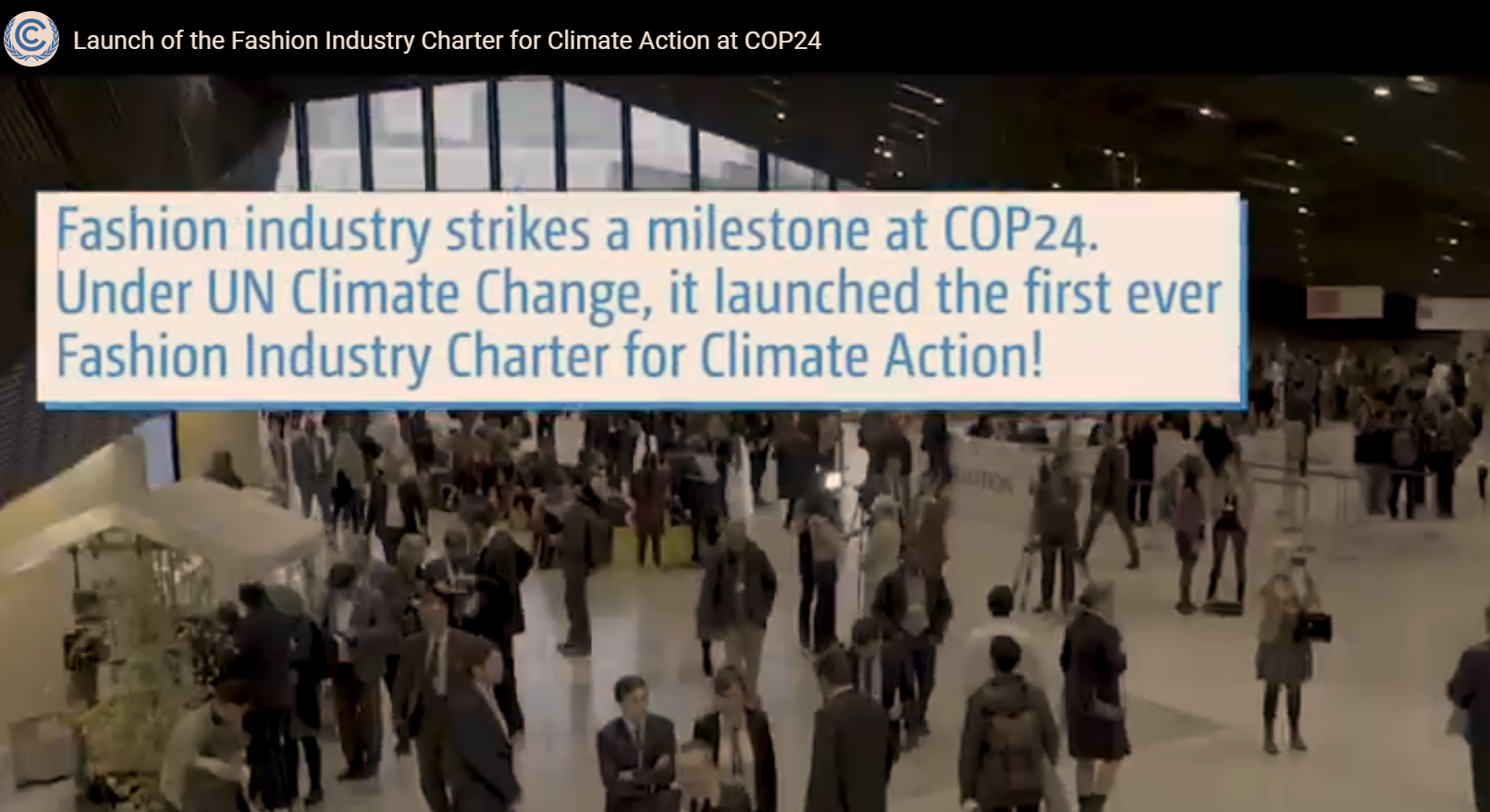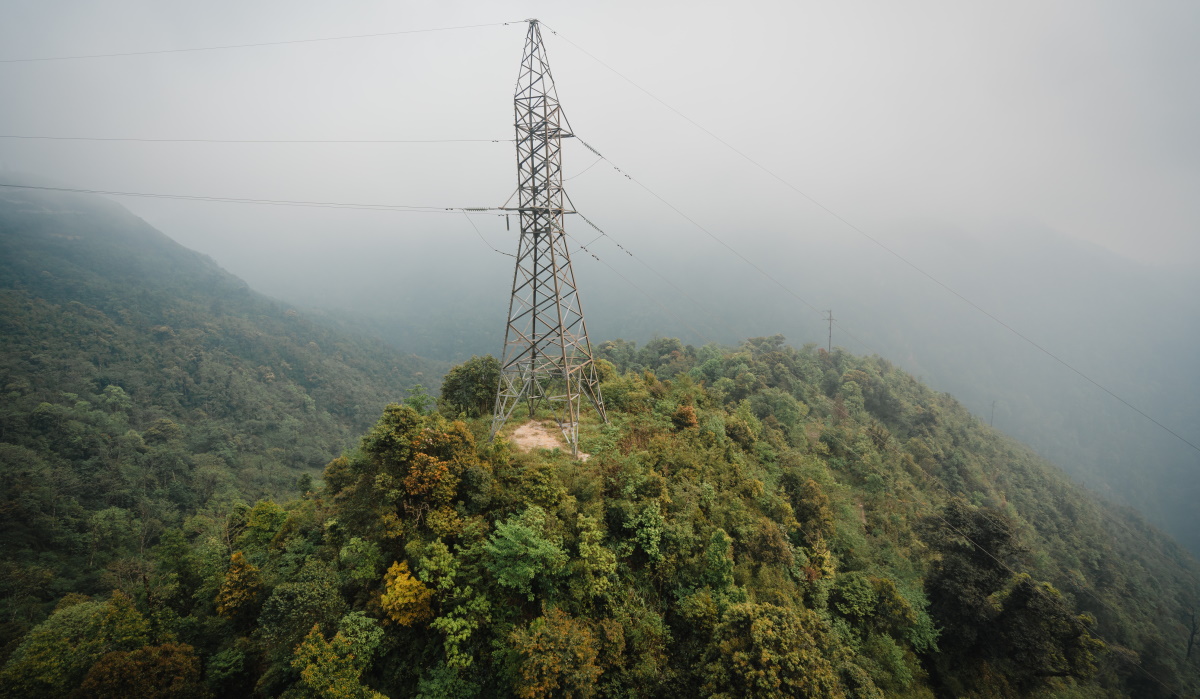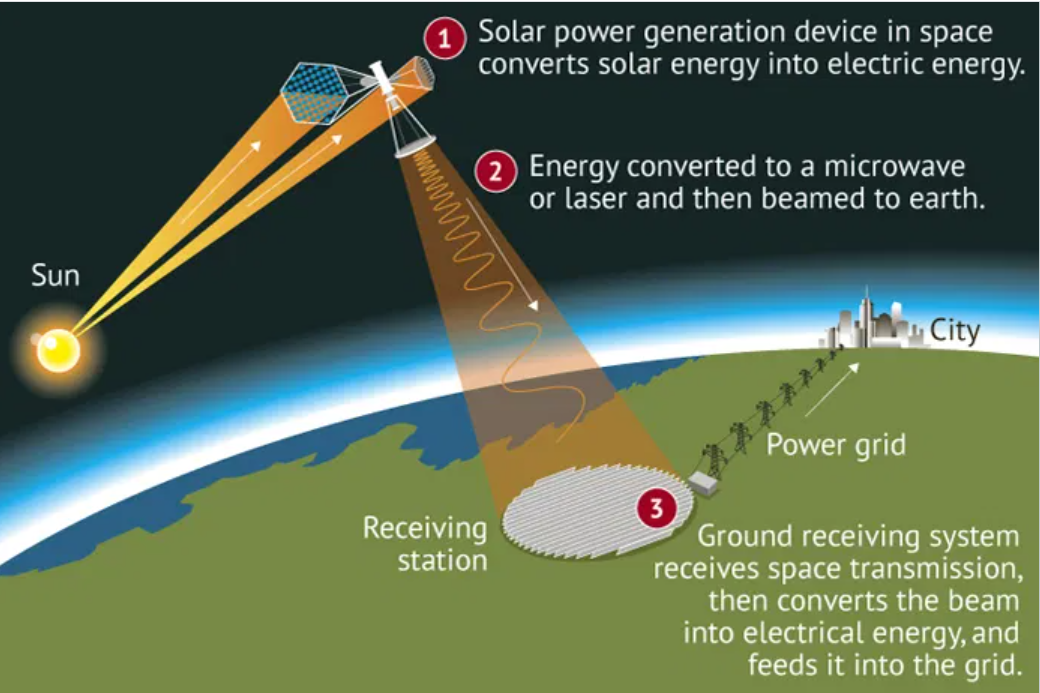December 2019: Being paid to use electricity?!
Welcome to the December newsletter from the Oxford Martin School Programme on Integrating Renewable Energy. In this edition we focus on the need for flexible energy systems, the UK general election, and the cost of fast fashion! If you have been forwarded this email and like it, please do subscribe directly!
Helen Gavin
Being paid to use electricity?!

An early Christmas present was delivered last weekend: a paradigm shift to being paid to use electricity! Householders on tariffs such as Agile Octopus were alerted to the fact that they would be paid for using electricity during certain times and so could freely use and schedule electrical appliances such as heaters, the dishwasher, as well as charge appliances and electric vehicles.
This was because a record breaking 16 GW of electricity was generated by wind on Sunday 8th December, providing over 43% of the nation’s needs. While being paid to use electricity isn’t unusual for industrial electricity users, it is a potential first for domestic households!
 The reason for negative prices was because there was more electricity on the grid than demand for it, and so prices started to fall. According to Kiwi Power, “The abundance of renewable energy saw imbalance prices tip into negative territory for the longest period in UK electricity market history”. Over the past week, prices on the energy market ranged from £121.04 to £-88.00 per MWh. It must be acknowledged however, that the reason for such price variability is also due to the inflexible thermal (for example gas, oil or coal plants) and nuclear plants which do not change their operating patterns.
The reason for negative prices was because there was more electricity on the grid than demand for it, and so prices started to fall. According to Kiwi Power, “The abundance of renewable energy saw imbalance prices tip into negative territory for the longest period in UK electricity market history”. Over the past week, prices on the energy market ranged from £121.04 to £-88.00 per MWh. It must be acknowledged however, that the reason for such price variability is also due to the inflexible thermal (for example gas, oil or coal plants) and nuclear plants which do not change their operating patterns.
Last weekend was an excellent showcase of some progress towards a smart flexible grid system which can respond positively to increased renewable energy on the grid. The experience is being heralded as a glimpse into the future, with more renewable electricity generators feeding the grid and when such responses will be the norm (unless the flexibility and storage capacity of our energy system is increased).
We need more flexible solutions… such as smart hot water tanks…
The need to roll out smart, flexible solutions that can use electricity at short notice has never been higher.
Such solutions allow us to use and store clean energy when prices are low or negative, and use this stored energy when there is less generation, offsetting the need for fossil fuel power generation. Such solutions also help prevent one of the ways in which excess electricity is managed i.e. turning off the supply from wind turbines and solar farms. But this is an incredible waste of clean, cheap energy. It is much better to make use of this energy using storage technologies so that we can use it at a later date when demand exceeds available supply. This storage can take many forms including smart, hot water tanks.
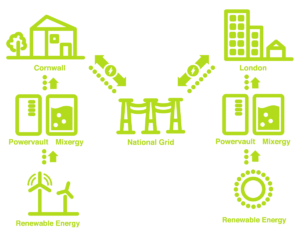 Researchers at Oxford University have teamed up with energy industry partners Upside, Powervault, Mixergy and the Eden Project in a pioneering trial funded by BEIS and Innovate UK. Called the PETE Project (Power, Energy, Technology, Efficiency), it explores how smart, efficient, hot water tanks can help balance the National Grid.
Researchers at Oxford University have teamed up with energy industry partners Upside, Powervault, Mixergy and the Eden Project in a pioneering trial funded by BEIS and Innovate UK. Called the PETE Project (Power, Energy, Technology, Efficiency), it explores how smart, efficient, hot water tanks can help balance the National Grid.
Data from Eurostat indicates that of all the energy used in the house, 15% is used to heat water. Further, 48% of gas used in the home is for water heating; or 11% of oil in households using it as a fuel source. Using excess renewable energy to heat water can therefore play a critical role in reducing greenhouse gas emissions and household costs.
According to Dr Pete Armstrong, CEO of Mixergy, “Using smart and efficient hot water tanks means we can heat during periods where energy is abundant and electricity prices are negatively priced, a phenomenon which is becoming increasingly prevalent. This enables the energy system to accommodate more renewable power whilst reducing primary energy consumption”.
 The PETE Project has placed around 300 smart hot water Mixergy tanks and 100 Powervault home batteries, into houses mostly in London and Cornwall, which are all connected together via the cloud. Aggregating large number of tanks and batteries together in this way creates an energy capacity equivalent to a power plant. This virtual power plant means considerable savings can be realised by deferring capital expenditure on new generation equipment.
The PETE Project has placed around 300 smart hot water Mixergy tanks and 100 Powervault home batteries, into houses mostly in London and Cornwall, which are all connected together via the cloud. Aggregating large number of tanks and batteries together in this way creates an energy capacity equivalent to a power plant. This virtual power plant means considerable savings can be realised by deferring capital expenditure on new generation equipment.
Analysing the data from batteries deployed to some households will help us determine how best to integrate thermal and battery storage. When there is a surplus of energy, the tanks use the energy to heat water. When there is less supply than demand, the batteries can provide power to the grid and the hot water tanks will stop heating.
Dr Sivapriya Bhagavathy , a researcher with the Oxford Martin Programme on Integrating Renewable Energy, is part of the team analysing data from the trial. She is looking to ascertain patterns of household consumption of hot water, the potential residual capacity of the tanks to see how much storage could be used, and how the concept could be scaled, which will lead to a decision on the success of the overall approach.
, a researcher with the Oxford Martin Programme on Integrating Renewable Energy, is part of the team analysing data from the trial. She is looking to ascertain patterns of household consumption of hot water, the potential residual capacity of the tanks to see how much storage could be used, and how the concept could be scaled, which will lead to a decision on the success of the overall approach.
She says, “A key aim of the trial is to test how the storage assets can be run collectively as an interoperable and scalable system, that can offer 1 MW of balancing capacity to the National Grid. Another aim is to quantify true multi-vector storage potential in the households.”
If the concept is proven, it could allow operators to access new revenue streams such as the National Grid’s frequency response market, and also from the distribution network operator in terms of managing constraints on the network. Some of this revenue would be passed to the property owner participating in the scheme. Alternatively, it could mean that operators approach a property owner to host a tank in order for both partners to derive benefit: low cost hot water for the owner, and additional revenue streams for the operator.
…and more interconnectors please
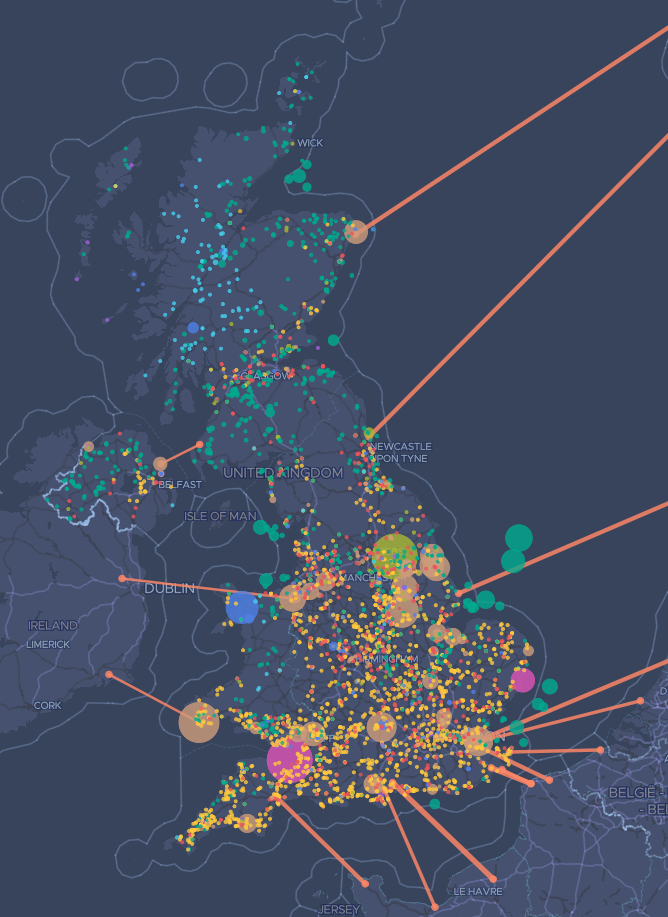 In addition to increased flexibility we also need more interconnectors, to help distribute large amount of clean generation from one particular location to others.
In addition to increased flexibility we also need more interconnectors, to help distribute large amount of clean generation from one particular location to others.
Interconnectors are cables that physically link different areas and allow electricity to be transported from where it is generated to where it is needed. They have a critical role to play in managing variable power production and balancing demand and supply over large areas. There are currently 4, connecting the UK to Ireland, France and The Netherlands, providing about 6% of the UK’s electricity.
Before Brexit, BEIS planned to have many more interconnectors both to buy and sell electricity to the European mainland. It estimated that more than a fifth of our energy could come from interconnectors by 2025 due to plans for 11 new connections – shown by the orange lines on the image. However, because the UK is part of the EU Single Market and the Internal Energy Market which makes imports and exports tariff-free, there is great uncertainty over what may change with regard to prices and tariffs due to Brexit, and this may mean fewer interconnectors are constructed.
However, interconnectors are critically needed, not least due to the expectation that wind power can generate more power than the world currently needs. This is according to analysis by IEA, for turbines built in windy regions in shallow waters near the shore. Currently, offshore wind currently provides just 0.3% of global power generation, but it is expected the sector will grow to a $1tn (£780bn) industry, generation many terawatts of power over the next 20 years.
The Greenest Election ever?
 The forthcoming general election on 12th December, has been called the climate change election, given the calls from people young and old for the government to up its action to achieve net zero in response to the climate emergency. Never before has there been debates on climate change, awareness of poor air quality (both outdoors and indoors) commitment to should energy efficiency and low carbon power production. The UK could be a global leader on the drive to net zero, but only if the government commits to real action.
The forthcoming general election on 12th December, has been called the climate change election, given the calls from people young and old for the government to up its action to achieve net zero in response to the climate emergency. Never before has there been debates on climate change, awareness of poor air quality (both outdoors and indoors) commitment to should energy efficiency and low carbon power production. The UK could be a global leader on the drive to net zero, but only if the government commits to real action.
 The Association for Decentralised Energy (ADE) has called upon the main political parties to adopt a series of measures to achieve Net Zero. The ADE’s Dr Joanne Wade says, “Local onsite generation and energy management from thousands of businesses and millions of homes will be key to the UK’s net zero future. A zero-carbon energy system can only happen when energy customers and local energy are placed at the heart of the way that the UK meets its energy needs. We need to make it easier and simpler for consumers to participate in the energy market and make clear what the future of our buildings and energy system look like from their perspective.”
The Association for Decentralised Energy (ADE) has called upon the main political parties to adopt a series of measures to achieve Net Zero. The ADE’s Dr Joanne Wade says, “Local onsite generation and energy management from thousands of businesses and millions of homes will be key to the UK’s net zero future. A zero-carbon energy system can only happen when energy customers and local energy are placed at the heart of the way that the UK meets its energy needs. We need to make it easier and simpler for consumers to participate in the energy market and make clear what the future of our buildings and energy system look like from their perspective.”
The ADE urges a prioritisation of the Treasury’s review into funding the transition to a net zero economy. They call for truly cross-Governmental efforts to achieving our climate change ambitions. It also requests:
-
- The public sector achieve net zero by 2040: this will set an example and help build new markets and business models
- Existing and new buildings to be covered by minimum energy efficiency standards by 2040
- Energy systems to prioritise continuing gains in primary energy efficiency
- Treatment of all energy measures on an equal footing, acknowledging that demand reduction through energy efficiency, low carbon supply, and flexibility all have a critical role to play
- Ensure investment for low carbon technologies and clarity on future support
- A clear vision and concrete policies to decarbonise heat
- Policies to realise a truly smart energy system through the 2020s.
BEAMA , the UK trade association for manufacturers and providers of energy infrastructure technologies and systems has set out its requests for political parties:
, the UK trade association for manufacturers and providers of energy infrastructure technologies and systems has set out its requests for political parties:
-
- Brexit: ensure close alignment of product and environmental legislation with the EU
- Transition UK homes to use low carbon heat, and drive a national retrofit programme aimed at meeting net zero and tackling fuel poverty
- Make improving indoor air quality a government priority
- Continue work on improving electrical safety stands and regulatory enforcement in UK homes and across the industry
It also makes a general request that, “…in the next Parliament we have competent, coherent policy development and management, where regulations are adequately enforced.”
 The Solar Trade Association calls for the urgent delivery of key policies to build on the successes of the past decade and to unlock the true potential of solar in the UK. It sets out three key deliverables which would drive rapid deployment of solar helping to decarbonise the power sector by 2030:
The Solar Trade Association calls for the urgent delivery of key policies to build on the successes of the past decade and to unlock the true potential of solar in the UK. It sets out three key deliverables which would drive rapid deployment of solar helping to decarbonise the power sector by 2030:
-
- Hold regular ‘Contracts for Difference’ auctions which include solar
- Amend Ofgem’s remit to align with our legally binding Net Zero emissions target
- Establish a new strategy for rooftop solar, including:
- Business Rates reform
- Scrap VAT for solar/storage
- Zero-interest loans for solar/storage
- Higher building standards
- Fair payment for small-scale solar power exports
![]() The Renewable Energy Association flags that many renewable, resource management and clean technologies are facing a swathe of policy-related blockages that are inhibiting deployment and new investment. It’s policy recommendations aim to remove these barriers. In summary:
The Renewable Energy Association flags that many renewable, resource management and clean technologies are facing a swathe of policy-related blockages that are inhibiting deployment and new investment. It’s policy recommendations aim to remove these barriers. In summary:
-
- Ensure that the funding, integrated planning and delivery of the wholesale system change sits with No 10 and the Cabinet Office and appoint an independent body with strong enforcement capabilities to ensure policy that supports decarbonisation
- Ensure that renewable energy and clean technology are central to a Net Zero Treasury test for funding; and that the Treasury incentivises these technologies instead of fossil fuels
- Reform Ofgem. Ensure energy network operators are incentivised to modernise energy systems and deliver a major expansion of renewable energy generation capacity
- Help local authorities to reach Net Zero by providing ring-fenced funding
- Deliver a just transition by developing a workforce strategy that supports the creation of high-quality skilled jobs and transitions existing fossil fuel sector workers to the new economy.
QUIZ
 What are your priorities? ADE ask that you select the policies you think are the best, from the main three parties’ manifestos so that the ADE can advocate their deployment so we achieve net zero. The policies range from renewable electricity and heat, air quality, governance, skills, homes and businesses.
What are your priorities? ADE ask that you select the policies you think are the best, from the main three parties’ manifestos so that the ADE can advocate their deployment so we achieve net zero. The policies range from renewable electricity and heat, air quality, governance, skills, homes and businesses.
What’s fashion got to do with renewable energy?
 Maybe with some of the money earned by using flexible electricity tariffs you’ll be tempted to buy a Christmas jumper? This item is the Marmite of fashion: a festive fun item for some; or one of the worst examples of fast fashion for others.
Maybe with some of the money earned by using flexible electricity tariffs you’ll be tempted to buy a Christmas jumper? This item is the Marmite of fashion: a festive fun item for some; or one of the worst examples of fast fashion for others.
This year has seen calls for people to stop buying such single use garments, and reuse items or buy second hand ones. This is in part due to the large amount of microplastics and chemicals released when washed. It’s also due the growing awareness of the huge climate and energy footprint of the fashion industry, and its strong associations with environmental damage and social injustice across the globe.
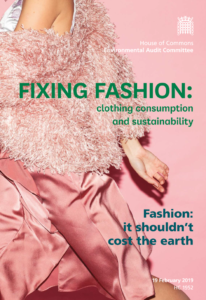 The House of Commons’ Environmental Audit Committee produced the report “Fixing fashion: clothing consumption and sustainability” in early 2019. It found that textile production is a major contributor to climate change- more than international flights and maritime shipping combined. The full life-cycle of clothing, globally, equates to 3.3 billion tonnes CO2 equivalent: nearly the combined annual carbon footprint of all 28 current members of the EU (3.5 billion tonnes).
The House of Commons’ Environmental Audit Committee produced the report “Fixing fashion: clothing consumption and sustainability” in early 2019. It found that textile production is a major contributor to climate change- more than international flights and maritime shipping combined. The full life-cycle of clothing, globally, equates to 3.3 billion tonnes CO2 equivalent: nearly the combined annual carbon footprint of all 28 current members of the EU (3.5 billion tonnes).
Every stage of the textile industry’s supply chain is energy-intensive, from processing yarn, producing fabric, and making, transporting and selling clothes. Using renewable energy is an important way that companies can lower the environmental footprint.
If fashion continues on its current path, it could use more than 26% of the global carbon budget associated with a 2°C pathway by 2050. In the UK, the total carbon footprint of clothing in the UK is growing: the clothing charity TRAID warned that ‘the over-consumption of clothes in the UK plays its part in deepening the main environmental challenges that we face at national and global level.’
Individually, consumers can reduce the environmental and social impact of the fashion industry by wearing clothes for longer, repairing, swapping or buying second hand. They can make demands on retailers, producers and manufacturers to reduce their impact.
Further, it is good to know that there are initiatives and fashion industry stakeholders who are working together to make change.
Here are some.
Organizations such as Fashion For Good encourage manufacturers to measure and reduce their energy use, use renewable energy and reduce greenhouse gas emissions through its Cradle to Cradle certification process.
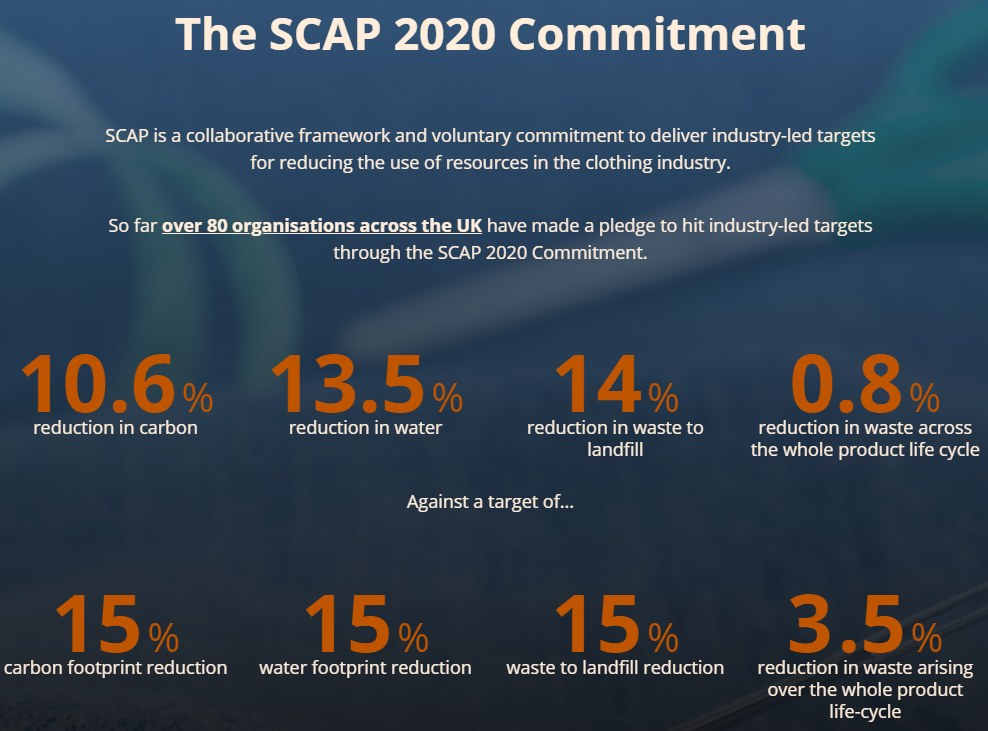 In the UK, members of WRAP’s Sustainable Action Clothing Plan (SACP) account for more than half of the UK clothing market (60%) in terms of volume, and have outperformed the rest of the industry in cutting carbon, water and waste. The SACP 2020 commitment has helped slash the environmental impact of the UK clothing sector and promoted the reuse, repair and recycling of items. The SACP knowledge hub identifies the carbon, water and waste savings that are possible throughout the clothing life cycle.
In the UK, members of WRAP’s Sustainable Action Clothing Plan (SACP) account for more than half of the UK clothing market (60%) in terms of volume, and have outperformed the rest of the industry in cutting carbon, water and waste. The SACP 2020 commitment has helped slash the environmental impact of the UK clothing sector and promoted the reuse, repair and recycling of items. The SACP knowledge hub identifies the carbon, water and waste savings that are possible throughout the clothing life cycle.
 The RE100 initiative commits signatories to using 100% renewable energy to power all their global operations: eight fashion retailers have signed up (date in brackets is the date by when 100% of the electricity will be renewable powered) – Bestseller (2021); Burberry (2022); H&M (2030); JD Sports Fashion (2025); Marks & Spencer (already 100%); Next (already 100% in UK and Ireland; globally by 2030); Ralph Lauren (2025) and Yoox Net A Porter (2020).
The RE100 initiative commits signatories to using 100% renewable energy to power all their global operations: eight fashion retailers have signed up (date in brackets is the date by when 100% of the electricity will be renewable powered) – Bestseller (2021); Burberry (2022); H&M (2030); JD Sports Fashion (2025); Marks & Spencer (already 100%); Next (already 100% in UK and Ireland; globally by 2030); Ralph Lauren (2025) and Yoox Net A Porter (2020).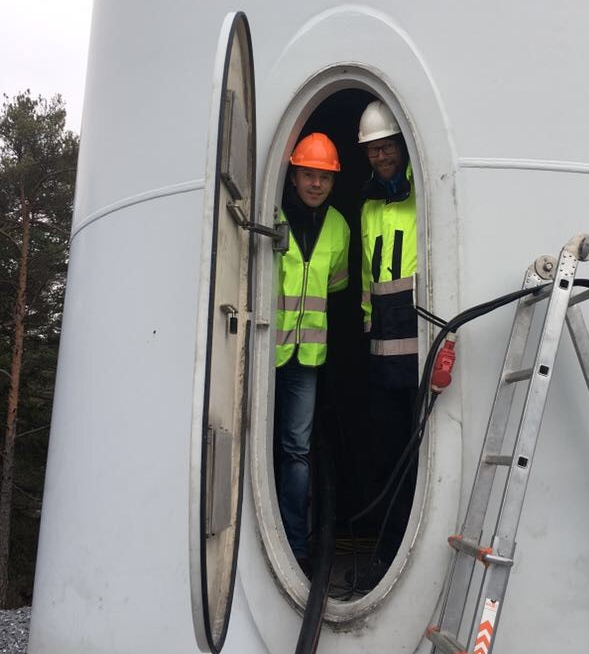
They can do this by arranging power purchase agreements, buying Green Power Products or offsets, upgrading machinery or creating their own renewable energy installations. For example H&M has helped to finance Tågeröd wind farm through GO².
Further, organisations and companies can sign up to the UN Fashion Industry Charter for Climate Action. This was created by industry stakeholders to unite both buyers and manufacturers, and bind them to climate-related commitments, including using renewable energy, prioritising the use of low-climate impact materials, achieve a 30% reduction in GHG emission reductions by 2030, and set science-based decarbonization goals. There are 89 organisations that have signed the Charter and 28 that have pledged their support.
 Separate to this, companies such as Nike and Gap set their own renewable energy targets.
Separate to this, companies such as Nike and Gap set their own renewable energy targets.
Based on the UN Fashion Industry Charter, British Fashion Council, DHL and others have set out a number of recommendations for companies both in the UK and globally, to address the industry’s environmental impacts. Of these, “A continued focus on reducing energy and resource consumption across all stages of the fashion lifecycle is the no brainer”. The partnership with DHL is significant and addresses the transportation aspects of the fashion industry.
—————————————————
Thanks for reading!
Thanks for reading to the end of this newsletter: the last of the decade from the Programme on Integrating Renewable Energy!
I wish you many low-carbon celebrations for the festive break and a renewably powered 2020.
Helen

